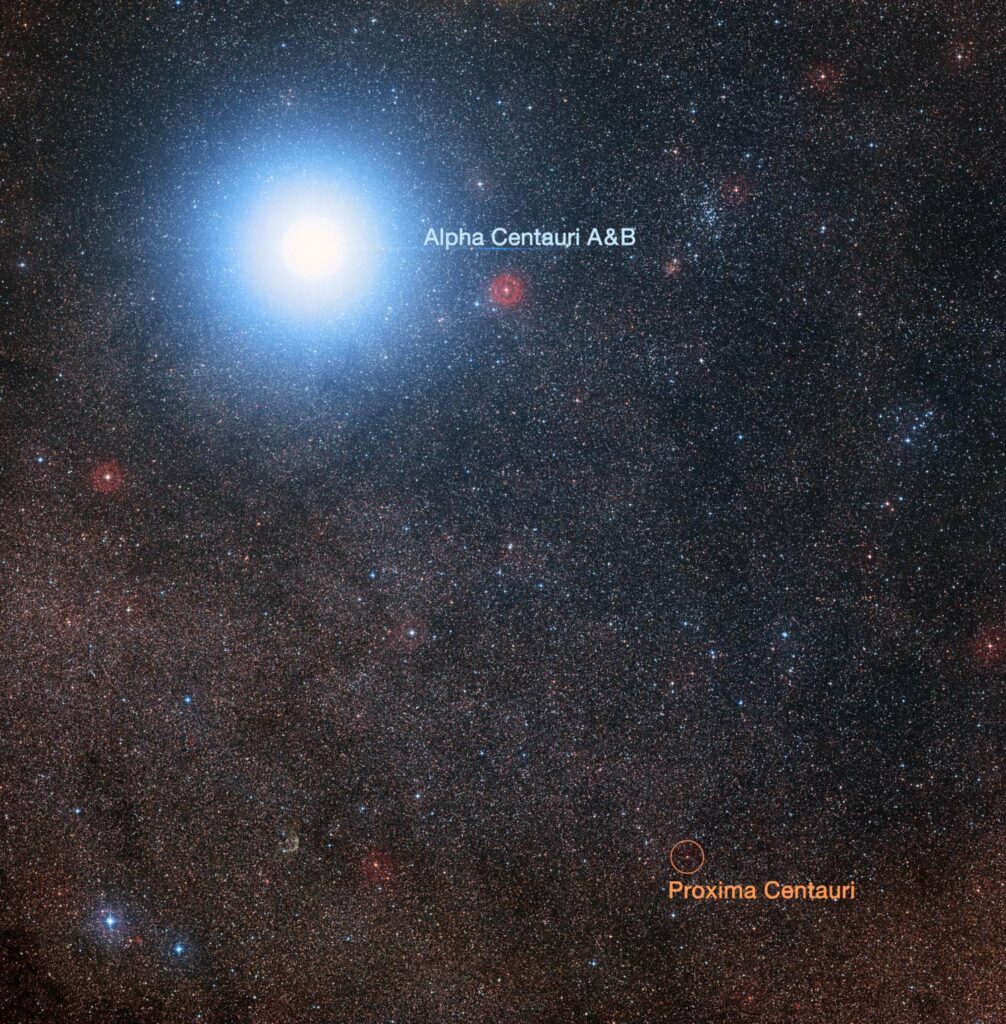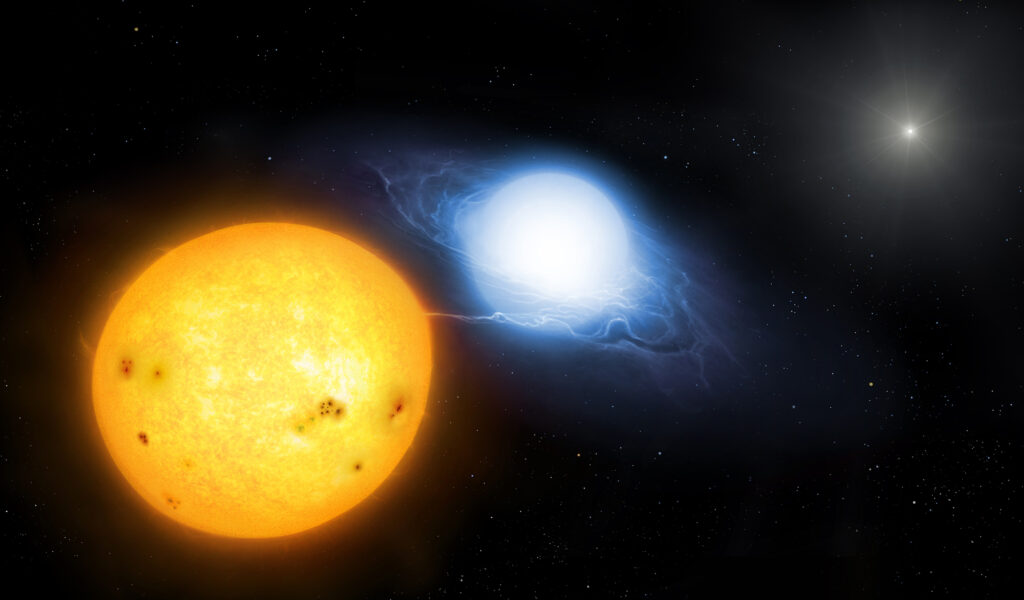On World Radio Day, it is worth remembering that the signals of our radio stations and TV channels travel wide into the universe. Together with them, news about events on Earth flies to other worlds. Here is a story about 10 stars and 10 events that have just been broadcasted to them.

1. α Centauri
α Centauri is the closest star to the Solar System. Meanwhile, a signal flies as long as 4.38 years to get there. This means that one of the most recent news dispatched there is the decision of the Patriarch of Constantinople to withdraw the Ukrainian Orthodox Church from the jurisdiction of the Moscow Patriarchate.

In fact, α Centauri consists of three stars — the yellow and orange A and B components and the red dwarf Proxima Centauri. The latter is actually the closest star to us, since it circles around the main components in a very elongated orbit and is now in its closest position to the Sun.
At least two exoplanets orbit Proxima Centauri. One of them is a sufficiently cool super-Earth. Most likely, it is constantly turned to its star with one side.
2. Sirius
α of the Canis Major, or Sirius, is the brightest star in the earthly sky. It is less than 9 light years away. One of the most important earthly news, having been just transmitted to potential intelligent beings living there, is the beginning of the Revolution of Dignity in Ukraine.

However, local residents are not yet aware that mass protests against the usurpation of power by Viktor Yanukovych are called that way. The name “Euromaidan” is mostly heard in the world news
Alas, there are no local residents in the vicinity of Sirius who could appreciate the indomitability of the Ukrainian spirit. This binary system consists of two hot white stars. The main one is 26 times brighter than our Sun and quite young. Even if it had planets, intelligent life would not have had time to develop on them.
The second star is a white dwarf. It was once much larger, but over time it exhausted its thermonuclear fuel, passed the red giant stage and became the way we see it now.
3. τ Ceti
In the vicinity of τ (tau) Ceti — which is one of the nearest sun-like stars to us — the release of the latest Harry Potter film is eagerly awaited. Or it has just been watched and is already being discussed — depending on how accurately we have estimated the distance to this star system.

Of course, this film was released in 2011 and has already become history on Earth. But τ Ceti is at a distance of 11.8 light years from us, and according to the laws of real, not magical physics, the information could not have gotten there earlier.
By the way, unlike Sirius, intelligent beings can really live somewhere around τ Ceti. Scientists are now firmly convinced that it has at least four planets, two of which may be in the habitable zone. More precisely, seven planets were initially discovered, but the existence of three of them was later questioned. However, astronomers assume that a third planet may be lurking between two ones in the zone of life.
4. Van Maanen Star
Van Maanen Star is the closest stand-alone white dwarf to us: it is 14 light-years away from the Sun. They have just received a signal from Earth that Barack Obama had become the 44th president of the United States. It is difficult to say how the local residents would react to this news, especially since they are most likely do not actually exist.

The star is named after the American astronomer Adrian van Maanen, who in 1917 noticed its significant own movement in the sky. Its mass reaches 67% of the mass of the Sun, but its size is compared with the Earth.
Like all white dwarfs, the van Maanen star is the core of a red giant that has once exhausted its entire supply of fusion fuel and shed its outer shells. It has an extremely high density: a teaspoon of its substance weighs many tons.
The van Maanen star has been in a white dwarf state for almost 4 billion years. All this time, it is slowly cooling down and now has a temperature is as little as 4000 K. Despite the relatively small distance, it cannot be seen with the naked eye
5. Gliese 581
The red dwarf Gliese 581, located at a distance of 20.4 light years, recently received news of the Sknyliv tragedy. In July 2002, a Su-27 multirole fighter crashed into spectators during an air show near Lviv. 77 people died and another 250 were injured.
Red dwarfs, to which Gliese 581 belongs, are the most common type of stars in the universe. In the vicinity of the solar system, 75% of all luminaries are like this. But the luminosity of these objects is so small that it is almost impossible to see them in the sky with the naked eye.

Gliese 581 is known first of all for the fact that it was near it that the first Earth-like planet in the habitable zone was discovered. Since then, worlds in the vicinity of this star in the constellation Libra have been repeatedly discovered and recognized as non-existent.
Five planets are now generally recognized, one of which is in the habitable zone. Gliese 581 is one of the prime candidates for the search for extraterrestrial civilizations. Later, a radio message was even sent there, which is still “on the way”.
6. Vega
Vega (α Lyra) has just received news that the developed nations of Earth will be building a space station together. This is an agreement signed by the governments of the EU, USA, Russia, Japan and other countries in 1998. As a the construction of the orbital complex was commenced, which was then called “Alpha”, and is now known simply as the International Space Station.

The brightest star in the Lyra constellation is located 25 light years away. So it is not surprising that the news arrives there with such a delay. In general, Vega is a white star of the main sequence, quite similar to Sirius. Though, it does not have a small white dwarf companion.
Vega rotates extremely fast on its axis. Because of this, its shape is noticeably different from a sphere: its equatorial radius is larger than the polar one, and it looks a little compressed. Infrared studies show the presence of a debris disk.
7. Arcturus
The most shocking news that has recently reached the star α Boötis, also known as Arcturus, is the massive explosion that occurred at the Chernobyl nuclear power plant on April 26, 1986. Then the 4th power unit was completely destroyed and a significant amount of radioactive materials got into the environment, and all the inhabitants had to leave the city of Pripyat.
At a distance of 36.7 light years, Arcturus is one of the closest giants to us. However, it should not be considered red, but orange, since it belongs to the class K. It is about a third more massive than our star, but it has a radius of 25 times that of the Sun and a luminosity of 110 times.
Arcturus is the first star in which its own movement was discovered, that is, a gradual change in position relative to its neighbors in the celestial sphere. It is now known to be part of a stellar stream, a group of objects with very similar velocity vectors that were once part of a dwarf galaxy engulfed by the Milky Way.
8. Aldebaran
But intelligent beings living near another red giant — Aldebaran — could be much more optimistic about humanity’s scientific prospects. A few months ago, the pulsating signal of the first artificial satellite built by Sergey Korolyov reached this dawn, after which the news arrived that the United States had launched its first satellite, named Explorer 1.
Aldebaran, or α Taurus, is 65 light years away. In fact, it is not a single star, but a whole complex system. Its main component is a red giant, the mass of which is 16% greater than that of the Sun, but it is 45 times larger than our luminary.

A gas giant orbiting the star is about six times more massive than Jupiter. It makes one rotation in 628 days, that is, in almost two Earth years. There are also five faint stars around the red giant. The latest studies show that they are not physically related to it and only one red dwarf can be a satellite orbiting the star at a distance of several hundred astronomical units.
9. Regulus
Regulus, or α Leo, is one of the closest blue stars to us. The distance to it is 79.3 light-years, so now radio waves are bringing news there about the course of the Second World War. One of the latest news for local listeners is that the Allied troops had landed in Sicily.

The young blue subgiant Regulus has outer layers twice as hot as our Sun’s. In addition, this star is approximately 3.5 times more massive than the one around which the Earth rotates, and its luminosity generally exceeds that of the Sun by 350 times.
In addition, Regulus is not the only star of the system. A pair of satellites orbit around it at a distance of 4200 a.o. These are red and orange dwarfs, which, in turn, rotate around a common center of mass and are separated by a distance of 100 AU.
10. Algol
Meanwhile, in the Algol system, also known as β Perseus, the beginning of the Second World War has not yet been heard of. It is 93 light years away from us, so the radio waves still carry the message that India is still a British colony. One of the latest news that could be received here is that Mahatma Gandhi has launched a campaign of peaceful disobedience against colonialism.

Algol has been known since ancient times as a star that briefly decreases its brightness several times every few days. This made people negative associations, and even the very Arabic name “el-ghul” means the evil spirit.
People understood the reason for variability much later. The two components of the Algol system are a bright star of the main sequence and a much dimmer subgiant, being the source of matter flowing to the first of the luminaries. They revolve around each other with a period of 2 days 20 hours 49 minutes, so the dimmer of them periodically obscures the brighter one from ground-based observers. There is also a third component in the system — a white star that orbits the first two in about two years.
